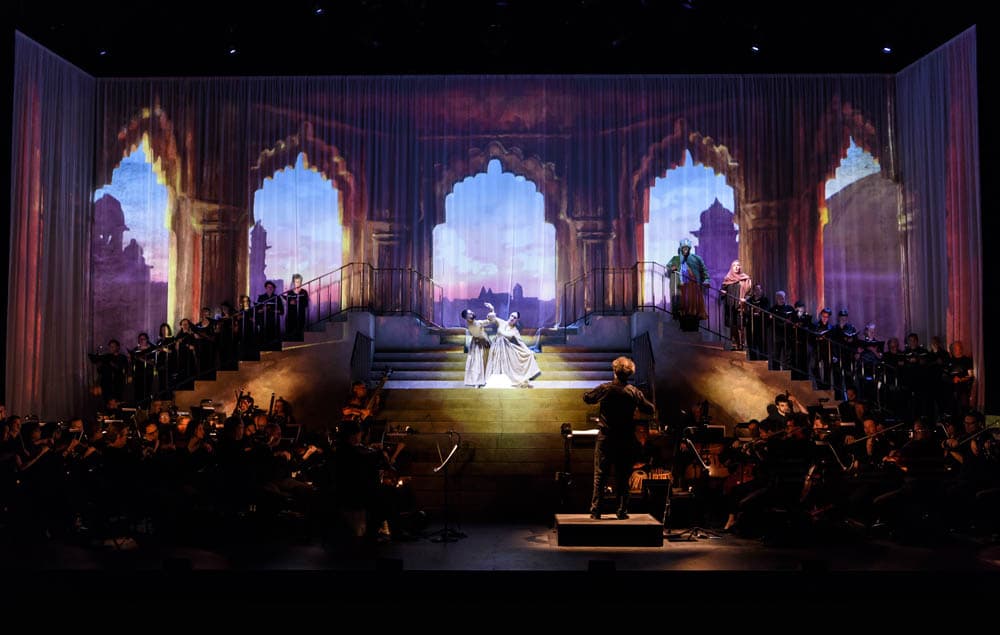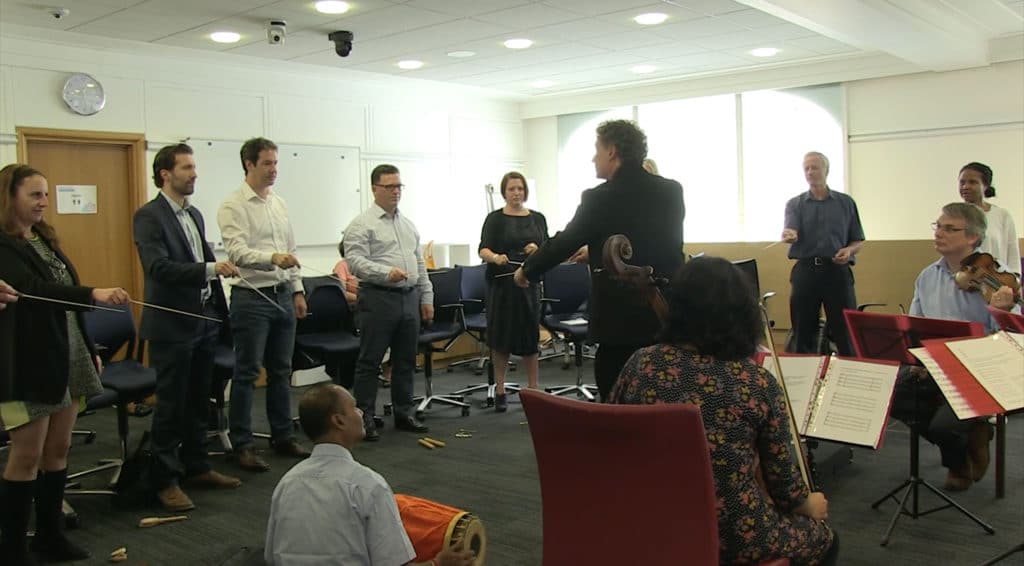30 Artists, 30 Years – David Murphy
BF: We have on many occasions had the pleasure of collaborating with you and your peers. The last was the unique Strauss Reflected, as well as Ravi Shankar’s opera Sukanya and Roots of Fire with Amjad Ali Khan. As a leader in your field, we have not only seen through our earlier collaborations where you held innovative and interactive workshops presented by Sinfonia Verdi in association with the foundation; but you have also continued to develop music and digital learning within your practice. Can you tell us more about your current projects and what you feel has been the impact of technology on the musical experience of your audience?
David Murphy: In recent years I have had the pleasure of undertaking some memorable and ground-breaking projects in collaboration with the Bagri Foundation. My current artistic focus grows out of these collaborations and is centred around sound: sound as music and sound as simply sound!
This work has an ambitious goal: to transform the live concert experience both in traditional concert venues and online. I’m aiming to do this by creating innovative ways for new and established audiences to experience an all-encompassing engagement with music and an appreciation of the universal power of sound.
I’m focussing especially on the needs of new, younger audiences by combining acoustic instruments and voices with electronic sounds – utilising the latest acoustic technology which young people experience in video gaming and virtual reality. The aim is to take listeners on a compelling sonic journey leading to a deeper experience of listening, and a visceral connection with the power of sound.
The initial mapping out of this work was supported by Arts Council England. I spent 9 months researching young people’s experiences of listening to both sound and music in schools in Luton. Results/observations/experiences from this time are documented here: www.deeplisteningproject.org
The majority of young people now experience music almost entirely via headphones. They are used to most of their music and sound experiences taking place “in their heads” (i.e through headphones) rather than with natural acoustics in the “outside world”. For this reason, a new audience member, hearing a live ensemble in a traditional concert space is likely to feel distanced from the experience – possibly one of the key reasons why live instrumental music is challenged when it comes to engaging new, younger audiences. One of my key aims now is the development of digital resources that will seamlessly integrate with acoustic instruments. This will enable contemporary acoustic musicians to connect with young audiences brought up almost exclusively on a diet of digital sound.
Music is about a direct connection, soul to soul – sometimes this connection can need nurturing in practical ways. Concert halls were first built in the Nineteenth Century for this reason – now we need a similar listening revolution. The impact of technology on the way we listen to music has been seismic. I hope my current work will enhance young people’s understanding of the power of sound and music, both acoustic and electronic, and look forward enormously to its development in the next few years.

BF: In order to continue to bring classical contemporaries to the fore, what advice would you give on how to be innovative with one’s practice whilst also finding a balance with maintaining the integrity of traditional practices?
DM: The essence of my answer to this question is: find the timeless elements of your practice and be innovative with them. If they are truly timeless, you can be as innovative as your imagination allows without compromising the purity of your art form.
I think our most recent collaboration together, Strauss Reflected is a good example of this, and this recent video https://youtu.be/Zb8AaNPnIc8 (which includes a short excerpt from that memorable concert with John Suchet and Meeta Pandit) shows how although we were using old music – the music of the Strauss Family from Nineteenth Century Vienna and the timeless tradition of North Indian Classical music, we created a new musical experience in the moment that night at Cadogan Hall.
This was only possible through reaching down to the timeless roots of both Indian and Western Classical music, to their origins in the physics of sound. This necessitated a very deep level of listening from all the performers on stage: the film is focussed on how conductors need to listen to be creative, but the same is true for all. Deeper listening = deeper awareness = deeper creativity.
BF: In light of recent events, we see people en masse turning to music, such as singing from balconies and playing instruments to lift morale. What part do you see music playing as part of the global discourse in which we find ourselves?
DM: One of the few positives in the current situation is the way the common enemy of Covid-19 has brought people together. All of humanity is on the same side and the best way to express this connection is through music.
As mentioned above, when you listen deeply, music is soul to soul contact. There are no misleading images or misconstrued words getting in the way. Why? Because sound is the language of the subconscious, deepest part of ourselves. Hearing is the first sense we experience, dawning at around 16 weeks in our mother’s womb and it is also the last sense to leave us when we depart the world. It is not surprising therefore that our instinct when we want to truly connect with each other is to use music – whether singing from balconies or streaming performances live over the Internet.
This is a time of turbulent, often indescribable emotions. Sound and music have the power to express these emotions in the most primal way and often with more precision than is possible with words and images, so I think music is currently playing an absolutely vital role in individual people’s lives and in the global discourse.
When this difficult period is over and it is time to celebrate the new world in which we find ourselves, music will be right there at the heart of the celebrations. I believe projects like our collaborations together: Ravi Shankar’s Sukanya, Roots of Fire with Amjad Ali Khan and Strauss Reflected, along with my current work with sound, are a model for the future. These projects reach down to the fundamental unity of all music and help to demonstrate an important truth: if you look deeply enough differences between cultures and nations are only on the surface.

Biography
David Murphy was born in Pembrokeshire, trained as a violinist at The Purcell School and the Guildhall School of Music & Drama, and performed widely as a soloist and chamber musician. He subsequently spent two years in research and teaching at Wichita State University, then studied conducting with Jay Decker, Gustav Meier, Seiji Ozawa and Léon Barzin.
With roots in the Western Classical Tradition, his work focusses on connecting diverse people and communities through the shared experience of sound. This pioneering musical journey was inspired by the combined forces of three musical greats: legendary violinist Yehudi Menuhin (leading to an exploration of Indian music and philosophy) Léon Barzin (giving him a direct line to the great conductors of the early Twentieth Century notably Toscanini, Furtwängler and Kleiber) and “the Godfather of World Music” Pandit Ravi Shankar with whom David had a close performing and composing relationship.
Combining tradition and innovation, he works at the cutting edge of contemporary performance art, his Deep Listening Project bringing audience engagement to a new level through multi-sensory experiences combining the traditional western orchestra with electronics and projection alongside musicians, dancers and acrobats from a range of global cultural traditions.
His conducting career began as assistant to Sir Charles Mackerras at both English National Opera and the Royal Opera House, and as conductor at Longborough Festival Opera. He is now a regular guest conductor with orchestras including the London Philharmonic Orchestra (with whom he gave the world premiere of Ravi Shankar’s Symphony in 2010, recorded for the LPO Label), the Scottish Chamber Orchestra (including the world premiere of Amjad Ali Khan’s sarod concerto Samaagam, recorded for Harmonia Mundi), the Residentie Orkest (including the European premiere of Holst’s Indra), the London Sinfonietta (including Holst’s Savitri), the Philharmonia Orchestra (including the London premiere of Indra), the Royal Philharmonic Orchestra and Britten Sinfonia. He is Musical Director of Sinfonia Verdi and a Fellow of the Royal Society of Arts.
With the support of the Bagri Foundation, David completed the score for the world’s first East-West Opera: Ravi Shankar’s Sukanya, conducting the world premiere performances of the opera at Curve, Leicester, The Lowry in Salford, Symphony Hall Birmingham and Southbank Centre’s Royal Festival Hall. He was invited to open the Southbank Centre’s Shankar100 Festival in January 2020 performing Shankar’s Sukanya with the London Philharmonic Orchestra, with whom he also recorded the work.
“Conductor David Murphy, who completed and orchestrated the work, masterfully brought the ingredients together: the London Philharmonic Orchestra, choir, classically trained singers and Indian musicians.” Simon Broughton, London Evening Standard
Interviewed by Halime Özdemir, Project Manager – May 2020


